
15 minute read
Milk forecasts go both ways
Hort bank lending on the rise
Hugh Stringleman hugh.stringleman@globalhq.co.nz
BANK lending to the agricultural and horticultural sectors grew in the June quarter, led by Rabobank and ASB, while ANZ decreased its still market-leading position.
Total lending at June 30 was $60.82 billion, up by $64 million compared with March 31.
ANZ went down by $292m, Rabobank up by $220m and ASB up by $124m.
ANZ remains with the largest market share, 26.3%, followed by BNZ on 21.1%, Rabobank 18.7%, ASB 16.9%, Westpac 15.2% and Heartland 1%.
It was the first quarter of loan growth for some time because the dairy industry dominance has in recent times featured loan repayments from good milk payouts.
In the latest quarter of Reserve Bank of New Zealand reporting on agri-loans, dairy’s share fell by $199m to $38.18b, whereas horticultural borrowing increased by $218m to $5.95b.
Lending to sheep, beef, cropping and other agricultural businesses was steady at $17.5b.
Dairy loans have fallen by $1.63b over 12 months, a 4% rate of decrease.
NZAB, the NZ-wide agricultural loan broker, which analysed the Reserve Bank figures, pointed out that lending to agricultural and horticultural sectors is less than 13% of total bank lending.
That indebtedness total is now $478b, up $10b or 2.1% over the quarter, and up 6% in the past 12 months.
Some 80% of that growth was in home loan debt.
ANZ is the biggest loan bank, at $140b, followed by ASB, BNZ and Westpac all with $90-$100b each.
Banks reported that 1.48% of their agri-loans were classed as non-performing and the range across all banks varied from 0.5% for ANZ to 2.9% for Rabobank.
STATS: In the latest quarter of RBNZ reporting on agri-loans, dairy’s share fell by $199 million, whereas horticultural borrowing increased by $218m.
NEW FROM
D r Bert Quin Dr Bert Quin

The amazing new fertiliser for peat and low P retention (low ASC) organic soils
QUINFERT ALLOPHOS ™ (patent applied for)
• High-analysis nutrients pre-incubated with high allophane-content subsoil • The allophane binds water-soluble phosphate, in plant-available form, minimising phosphate leaching and run-off • It also stabilises the soil organic matter, greatly reducing CO2 GHG emissions • Reduces maintenance lime requirements • Contains N-vig™ nitrogenated root stimulator • Contains zeolite to minmise loss of ammonia and cations • Available as 1.5 – 4 – 2 – 4 – 11 – 1 N-P-K-S-Ca-Mg (‘Allophos 2K’) and higher- potash blends • Apply at 500-750 kg/ha twice a year
INTRODUCTORY PRICE (North Island only) $290/t + GST ex McPherson’s Te Poi Call Regan Beaver at Quinfert Waharoa bag depot on 021 873 748 or Bert Quin direct on 021 427 572 Quinfert – the thinking farmer’s choice www.quinfert.co.nz
For more info, email Bert Quin on bert.quin@quinfert.co.nz, or phone 021 427 572, or visit www.quinfert.co.nz For more info, email Bert Quin on bert.quin@quinfert.co.nz, or phone 021 427 572, or visit www.quinfert.co.nz annual amount you are using now. Easy to mix with your prilled urea. Leaching of anions like nitrate will be minimised as well. annual amount you are using now. Easy to mix with your prilled urea. Leaching of anions like nitrate will be minimised as well. Fact 10. Potash is more e cient, and must less likely to cause metabolic problems, if applied in small doses 4 times a year, adding up to 50-60% of the total Fact 10. Potash is more e cient, and must less likely to cause metabolic problems, if applied in small doses 4 times a year, adding up to 50-60% of the total cut in half with big savings. cut in half with big savings. Fact 9. For N, rather than granular urea, use prilled urea, sprayed immediately prior to, or during, the spreading with urease inhibitor. Use of N can be literally Fact 9. For N, rather than granular urea, use prilled urea, sprayed immediately prior to, or during, the spreading with urease inhibitor. Use of N can be literally situations or low rainfall, use a blend of RPR and high-analysis soluble P. situations or low rainfall, use a blend of RPR and high-analysis soluble P. Fact 8. In a nutshell, for maintenance of P levels any genuine RPR (not an RPR/Boucraa mix please!) can be used. Just check the Cd content. For low fertility Fact 8. In a nutshell, for maintenance of P levels any genuine RPR (not an RPR/Boucraa mix please!) can be used. Just check the Cd content. For low fertility strips can be harvested in summer to be fed out, to improve P and N cycling. strips can be harvested in summer to be fed out, to improve P and N cycling. bacterial and sediment losses. Neither will have any signi cant long-term bene cial e ect (on a whole -farm basis) on soluble P and nitrate-N loss. But grass bacterial and sediment losses. Neither will have any signi cant long-term bene cial e ect (on a whole -farm basis) on soluble P and nitrate-N loss. But grass Fact 7. in any case simple fenced-o 3-metre wide grass riparian strips are essentially as e ective and vastly cheaper than more complex strips. Both reduce Fact 7. in any case simple fenced-o 3-metre wide grass riparian strips are essentially as e ective and vastly cheaper than more complex strips. Both reduce idea of their long-term e ectiveness and maintenance costs, and before you have established whether changing to sustained-release RPR is all you need to do! idea of their long-term e ectiveness and maintenance costs, and before you have established whether changing to sustained-release RPR is all you need to do! Fact 6. It is nonsensical to give in to pressure to install expensive mitigations riparian strips, excessively large wetlands and ‘phosphorus walls’ when you have no Fact 6. It is nonsensical to give in to pressure to install expensive mitigations riparian strips, excessively large wetlands and ‘phosphorus walls’ when you have no huge amounts of money! huge amounts of money! Fact 5. Following 1-4 above will greatly reduce P run-o and leaching. This should be done before anything else, and the situation reassessed before spending Fact 5. Following 1-4 above will greatly reduce P run-o and leaching. This should be done before anything else, and the situation reassessed before spending (sulphur 90) is far more e cient than the excess sulphate in super. (sulphur 90) is far more e cient than the excess sulphate in super. Fact 4. There is nothing to lose and everything to gain. RPR-based fertilisers are even cheaper than super-based products as well! Added sulphur bentonite Fact 4. There is nothing to lose and everything to gain. RPR-based fertilisers are even cheaper than super-based products as well! Added sulphur bentonite in a sustained fashion for plants. in a sustained fashion for plants. Fact 3. If you want to build up your soil P in an environmentally-protective way, simply apply R Fact 3. If you want to build up your soil P in an environmentally-protective way, simply apply R environment. environment. Fact 2. Once you have Olsen P levels that are more than a third of the P retention (ASC), application of additional soluble P is very prone to loss to the Fact 2. Once you have Olsen P levels that are more than a third of the P retention (ASC), application of additional soluble P is very prone to loss to the Fact 1. The overuse of soluble P fertiliser is by far the largest cause of P run-o and leaching, and therefore of the decline in the quality of Kiwi waterways. Fact 1. The overuse of soluble P fertiliser is by far the largest cause of P run-o and leaching, and therefore of the decline in the quality of Kiwi waterways. Ten Basic Fertiliser Facts You Must Know and Adopt to Meet 2025 Water Quality Limits:



CHANGE: Rabobank senior analyst Emma Higgins says GDT prices had moved sideways or lower for the past six months, until the latest lift.
Milk forecasts go both ways
Hugh Stringleman hugh.stringleman@globalhq.co.nz
A PREDICTED slowdown in Chinese import demand for milk powder is why Rabobank has trimmed 20c from its farm gate milk price forecast, now $7.80/kg milksolids.
The analysis of China’s needs and the cut in milk price expectation were done before the latest Global Dairy Trade (GDT) auction, in which the price index rose 4% and whole milk powder rose 3.3%.
Rabobank senior analyst Emma Higgins says all eyes are on China, our key export market, as the risk of downside in the milk price forecast.
“Supply is outpacing demand in China, with domestic milk production growth combined with growing inventories of dairy products,” Higgins said.
“These factors point to the potential for a period of destocking later this year and into 2022.”
Higgins says GDT prices had moved sideways or lower for the past six months, until the latest lift.
“Despite last week’s lift, we see a strong possibility that the nearterm peak in global prices is likely behind us,” she said.
“Our $7.80 forecast is at the lower end of all analysts’ expectations right now, but it would still be an excellent result for our dairy farmers – the secondlargest in Fonterra’s history.”
Rabobank’s Dairy Quarterly Report said China’s own milk supply is growing 6-7% annually and its milk powder importing has been up 40% in the first half of 2021.
It forecasts that importing will fall by 18% in the second half to drive some destocking.
Higgins also commented on other global supply and demand dynamics, which would influence the farm gate milk price.
These include the shape of the NZ spring peak and how global dairy demand holds up in the face of reductions in fiscal aid from governments worldwide.
High feed costs and growing margin pressure in the northern hemisphere may influence milk production, along with the added strain of inflation.
But while Rabobank counselled caution, BNZ senior economist Doug Steel published an upbeat research note on the milk price outlook and raised his estimate 50c to $8.30.
He says the balance of risks surrounding the milk price forecasts had moved upward and the $8.30 was not a precise estimate because of the time of the season and all the moving parts.
“The bounce in GDT prices follows a general lift in global risk appetite over recent weeks helping underpin demand,” Steel said.
There was firmness to the underlying demand and forward price curves showed high prices extending into next year.
Fonterra had removed quantities of WMP from the GDT platform citing strong demand through other sales channels.
Milk production growth in the European Union had been subdued.
“We still don’t expect a strong global milk supply response to strong dairy prices,” he said.
Even though the NZ season has started strongly and grass growth has been favourable in most of the country, BNZ doesn’t expect milk production this season to be greater than last season.
That is due to good production last season and the trend to fewer cows.
Steel pointed out that the NZD had risen 2.6% in value against the USD in the three weeks before the latest GDT event, which tended to work against the 4% index lift.
In summary, “the dynamics and balance of risks appear to be changing with robust demand bumping up against subdued supply”.
Doug Steel BNZ
#AginED ED FOR FUTURE AGRIPRENEURS!

Volume 74 I September 20th, 2021 I email: agined@globalHQ.co.nz I www.farmersweekly.co.nz/agined
Are you a parent or teacher and want to receive AginED every week directly to your email inbox? Send us an
email to sign up at agined@globalhq.co.nz
THIS GRAPH SHOWS THE NORTH ISLAND MUTTON SLAUGHTER PRICE IN $/KGCW
Award winning Taranaki farmers environmental journey has led to a number of unexpected but very valuable things including learning te reo Māori.
Damian and Jane Roper farm a 320 hectare dairy farm in South Taranaki. Their journey to owning their own farm has not been something that has happened overnight and has allowed them to explore some interesting and varied experiences along the way. Read the full article at
https://farmersweekly.co.nz/section/dairy/view/farming-journey-leads-to-learning-te-reo-maori
and see if you can answer the following questions. 1 What were some of the other jobs that Damian and
Jane did before dairy farming? 2 How long did it take them to own their own farm? 3 How many cows do they milk? What is their milk solid (MS) production per cow? 4 What supplementary feeds do they grow for their cows? 5 What do they use to decrease supplementary feed wastage?
What was the difference in the amount of feed fed in the first year of its use? 6 The Ropers journey learning te reo Māori allowed them to see that Māori environmental values were identical to their own.
What are these? 7 Damian and Jane are members of the WelFarm group. What is this and what purpose does this group serve? 8 What have the Ropers decided to replant their current 100ha pine lock with when it is harvested?

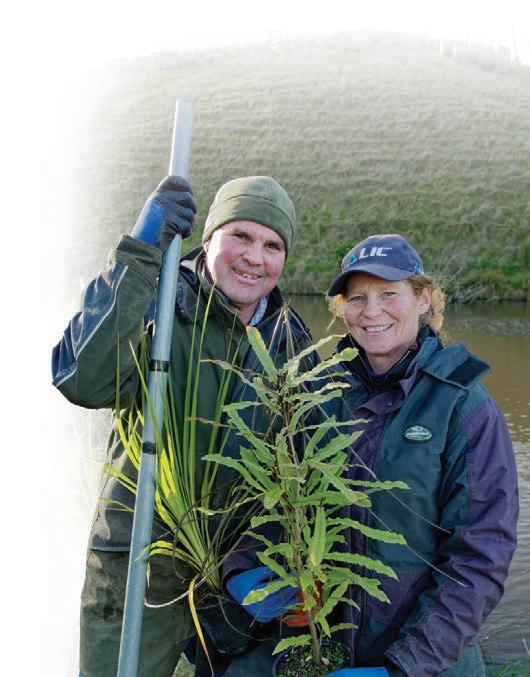
Identifying stress in yourself:
How do we learn to identify stress in ourselves? It is hard to go through life and avoid never feeling worried, anxious or stressed but with interesting times in the world, it is important that we talk about it and the signs.
Firstly, don’t compare what you feel stressed about to someone else’s stress. It is hard because our friends and family tell us what they are worried about and sometimes it can make our own situation feel inadequate. IT IS NOT! Always remember everyone has their own things going on in their life and so we cannot compare our journey to that of someone else. You are allowed to ‘feel all the feels’ and our abilities to handle how we are feeling are all so individually different. So don’t ever be hard on yourself as you learn how to grow your own resilience to life.
What are the physical signs of stress?
Muscle tension and pain, - Low energy - Headaches - Decreased appetite - Muscle spasms/tension - Shortness of breath or trouble breathing
*If you think you are suffering from stress and need help managing it, please talk to an adult in your household or ring/ text 1737 to talk to a trained counsellor. https://1737.org.nz/
Activity: If you start to feel like you are experiencing any one of the symptoms above then try these exercises. You can do them as many times in a day as you need and for as long as you think helps. ~ BOX BREATHING: ~ Breathe in for 4 counts, hold for four counts, out for 4 counts, hold for 4 counts. Repeat. ~ Deep belly breathing: ~ Over time, increase the amount of time you hold your breath for. ~ Make sure you are breathing from your belly so find somewhere comfortable to sit, lie down
What are the psychological signs of stress?
Trouble sleeping - Trouble concentrating - Difficulty relaxing - Difficulty concentrating - Irritable - Tearfulness - Feeling depressed
and close your eyes, handson your tummy, lying on your back with your legs up the wall is the best position! ~ This brings you back into rest and digest mode and out of
‘flight mode’. You will feel a sense of calmness after a couple of minutes of doing this. It is really important to not have any distractions while doing this so pop that phone onto silent mode! ~ Do something that makes you feel calm and relaxed: ~ This could be listening to music, having a bath, lighting a candle, doing some exercise, cooking, chatting to a friend and more. Have a wonderful week,
Harriet
POTTY-TRAINED COWS? A university of Auckland study in conjunction with affliated researchers from Germany have tested whether cows can be trained to urinate in a “toilet” at least some of the time. With the aim that if 80% of the urine could be captured then there could be a 50% reduction in ammonia produced. Have a read of the full article at ammonia produced. Have a read of the full article at https://
farmersweekly.co.nz/section/dairy/view/study-shows-cows-can-be-potty-trained Do you think this is something that would be viable on New Zealand farms and throughout the world? Is there a need for this type of innovation?
1 What is the latest value? 2 When have values been at the lowest level in the last two years? 3 When have values been at the highest level in the last two years?
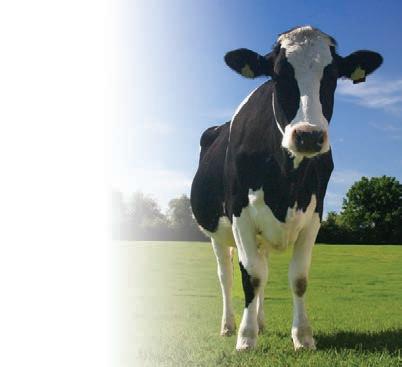

Have a go:
STRETCH YOURSELF:
1 How does the latest NI mutton value compare to the previous season? 2 How does it compare to the five-year average? 3 Due to strong demand from China, and growing interest from the US, the July average export value for mutton settled at $8.75/kg. What is the percentage difference compared to the five-year average of $5.99/kg and last year at $6.74/kg?
Calf Club NZ - Our fundamental goal is empowering rural kids across the country to care for and compete with their pet calves, and ensure the continued growth and development of our young farmers. Each year we see hundreds of stories and friendships develop between kiwi kids and their animals.
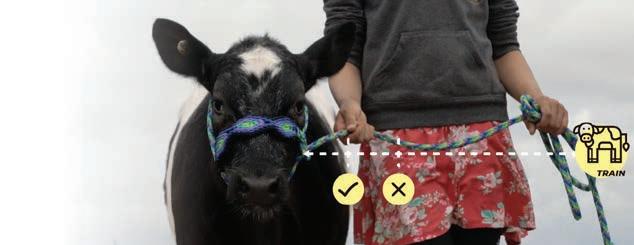
This picture demonstrates the correct way to hold your calf’s lead rope
CALF CLUB TIPS AND TRICKS
Is this your first year of Calf Club? Fear not! Here are a few tips and tricks from Calf Club NZ to help train your calf and improve your leading/rearing skills. Leading and Control - Georgia Whitworth, Calf Club NZ Judge
"One thing I love to see as a judge is a really happy kid. Make sure to have a big smile and stand nice and proud. When walking your calf, hold close to the halter so it can understand your movements." A Clean Calf - Crystal Scown, Hauraki Dairy Trainee of the Year 2020
"Calves don't stay clean for long. The trick is to give them a good wash the night before and leave their cover on overnight. Give them a good brush every day, and if they are moulting use a rubber glove to get rid of the loose hair. Overall make sure you love your calf and have fun." For more info head to www.calfclubnz.co.nz


